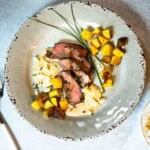
Pan Seared Denver Steak with Blue Cheese Sauce
Denver Steaks are seasoned simply, pan seared and finished in the oven, served with a rich, bold creamy blue cheese sauce, a satisfying combo that hits all the right notes for any steak lover.
Servings 4
Calories 580kcal
Equipment
- 1 Oven proof skillet Cast Iron Skillet or French Carbon Steel Pan
Ingredients
- For The Blue Cheese Sauce
- 2 Tablespoons Butter
- ¼ Cup Shallot Diced
- 1 Tablespoon All purpose flour
- ¾ Cup Heavy Cream
- 3 ounces Blue Cheese crumbled, plus more for garnish
- For The Denver Steak
- 2 Tablespoons Butter
- 2 Denver Steaks about 1 ¼ pounds total
- ½ teaspoon Kosher salt
- ¼ teaspoon Freshly ground black pepper
Instructions
- Bring steaks to room temperature, allow at least 30 minutes. Preheat oven to 400 degrees.
- For The Blue Cheese Sauce
- Melt 2 Tablespoons butter in a sauce pan over medium heat. Once butter is melted and bubbles have subsided, add the diced shallot and cook until tender, about 2 minutes.
- Add the flour and whisk until smooth. Cook about 1 minute, stirring, until the flour is starting to have a nutty flavor and is turning slightly golden.
- Stir in the cream and whisk until smooth and starting to thicken. Stir in the crumbled cheese and whisk until melted. Remove from heat, keep warm and cook the steak.
- Pan Sear The Denver Steak
- Add butter to an oven proof skillet. A cast iron skillet or a French Carbon Steel Pan. Melt butter over medium high heat. Once the butter is melted and bubbles have subsided, add the steak. Sear until golden browned on one side, about two minutes, then turn and sear on the other side.
- Transfer the skillet to oven and cook until internal temperature reaches desired doneness. I recommend medium rare, at 135 degrees.
- Remove the steak to a cutting board and tent with foil and let rest 10 minutes. Slice immediately, against the grain and serve.
- Spoon a couple of dollops of the blue cheese sauce onto a plate. Add a few slices of the Denver steak.
Notes
Tips For Success:
- Slicing: Once cooked, it's important to slice a Denver steak against the grain. An easy task, because if the steak has been cut correctly by the butcher, the shape of the steak will intuitively guide you.
- Pat the steak dry before pan frying. Drying the steak will remove any surface moisture which will result in a quicker and crispier sear.
- Don't overcook the steak: Use a digital meat thermometer to measure the internal temperature of the steak. To keep this steak melt in your mouth tender, I highly recommend keeping the cut cooked to medium-rare, which is 130-135 degrees.
- Don't overcook the sauce: Once the cheese has melted, remove it from the heat, cover with foil and keep warm. If it continues to cook, the texture will become greasy. If this happens, pour in a splash of milk to reconstitute the creamy texture.
- Presentation: Place a few sprigs of fresh thyme over each steak once they're heading into the oven. Not so much to add flavor, but baked stems make for a rustic garnish once the steak is sliced and plated.
- Finishing Salt: Every kitchen should have a box of Maldon Sea Salt Flakes. It's flaky, shiny and adds a beautiful garnish for any steak. Just sprinkle a pinch or two on top of each sliced steak serving, once plated.
Nutrition
Calories: 580kcal | Carbohydrates: 6g | Protein: 29g | Fat: 50g | Saturated Fat: 29g | Polyunsaturated Fat: 2g | Monounsaturated Fat: 16g | Trans Fat: 0.5g | Cholesterol: 165mg | Sodium: 698mg | Potassium: 456mg | Fiber: 1g | Sugar: 3g | Vitamin A: 1186IU | Vitamin C: 1mg | Calcium: 159mg | Iron: 2mg